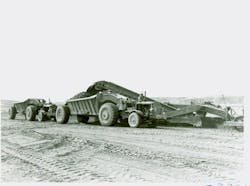In 1845, John Lyon of Harrisburg, Iowa, patented what is believed to be the first elevating grader. Dubbed the “Ditching Plow,” it was designed to excavate bank material and transfer it to a wagon moving alongside by means of a cross-frame conveyor. The concept has undergone a number of refinements and variations over the following 165-plus years, including direct evolution of Lyon’s towed machine, and conveyors of like design mounted on or traveling behind motor graders. The towed elevating grader was obsolete in the 1940s, and motor grader-mounted loaders fell out of use in the 1970s.
The largest and most productive descendant of the Ditching Plow is the traveling belt loader. This concept originated in 1940 when the Euclid Road Machinery Co. introduced its first Blade-Veyor, or BV, belt loader as a means of most efficiently loading its bottom dump wagons.
At 54 inches, the BV’s conveyor was wider than that of the largest elevating grader, and the BV wielded a large, horizontal cutting edge instead of a disc to break material from the bank. Rather than being positioned perpendicular, or nearly so, to the machine’s direction of travel, the BV’s conveyor angled across the length of the machine, so as to discharge at the opposite corner from the cutting edge, thereby giving the material as straight a direction of travel as possible. Although an elevating grader rode on wheels, the BV traveled on a crawler undercarriage; like the elevating scraper, it was towed by a large crawler tractor.
After six prototypes had been built, the BV program was suspended due to the demands of World War II. When it entered formal production in 1948, the BV achieved a reasonable degree of success as a means of quickly and efficiently loading large volumes of earthy material. But the design had its flaws: the dead weight and the maintenance costs of the undercarriage; the tendency of the belt to slip under load and its vulnerability to impacts from rocks in the bank; and its tendency to hang up or clog due to sloughed material and the steepness of the belt. The BV was ultimately phased out in 1956.
Montana earthmoving contractor Francis Holland had used seven BVs and developed a much larger loader that travelled on two crawler tractors rather than its own crawlers. Initial models had 72-inch belts and vertical cutting edges, and were touted for their simple design, greater power, superior performance, and lower maintenance costs. All of the Holland loader’s weight was on the powered crawlers of the transporting tractors, which allowed all of the tractive effort to be directed to the cutting edge while avoiding the clogs that had plagued the BV.
Holland patented his design in 1970 and 1971, and tested prototypes on his own jobs. In 1972 and 1973, three early production models joined a prototype at Perris Dam in southern California, where they loaded 110-ton bottom dump trucks in 43 to 90 seconds, depending on the material. Holland Loader Co. still produces Holland loaders today, with belt widths to 96 inches.
The Historical Construction Equipment Association (HCEA) is a 501(c)3 nonprofit organization dedicated to preserving the history of the construction, dredging and surface mining equipment industries. With more than 4,000 members in 25 countries, activities include operation of National Construction Equipment Museum and archives in Bowling Green, Ohio; publication of a quarterly magazine, Equipment Echoes, from which this text is adapted; and hosting an annual working exhibition of restored construction equipment. Individual memberships are $30 within the United States and Canada, and $40US elsewhere. We seek to develop relationships in the equipment manufacturing industry, and we offer a college scholarship for engineering students. Information is available at www.hcea.net, 419.352.5616, or [email protected].




